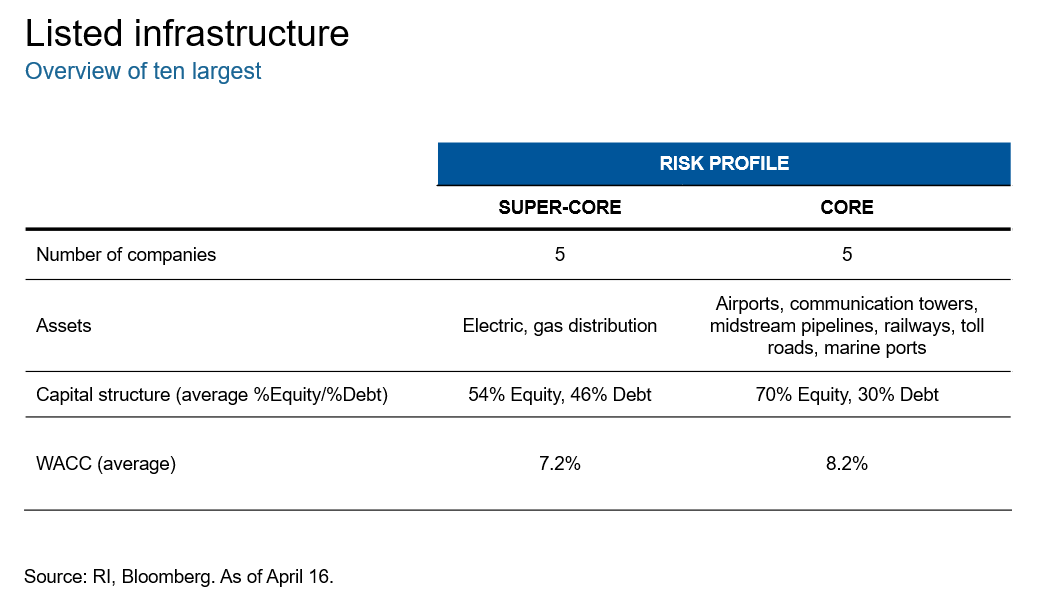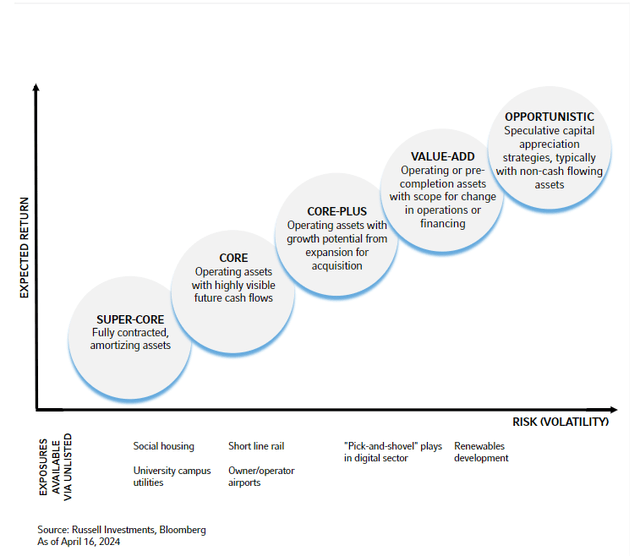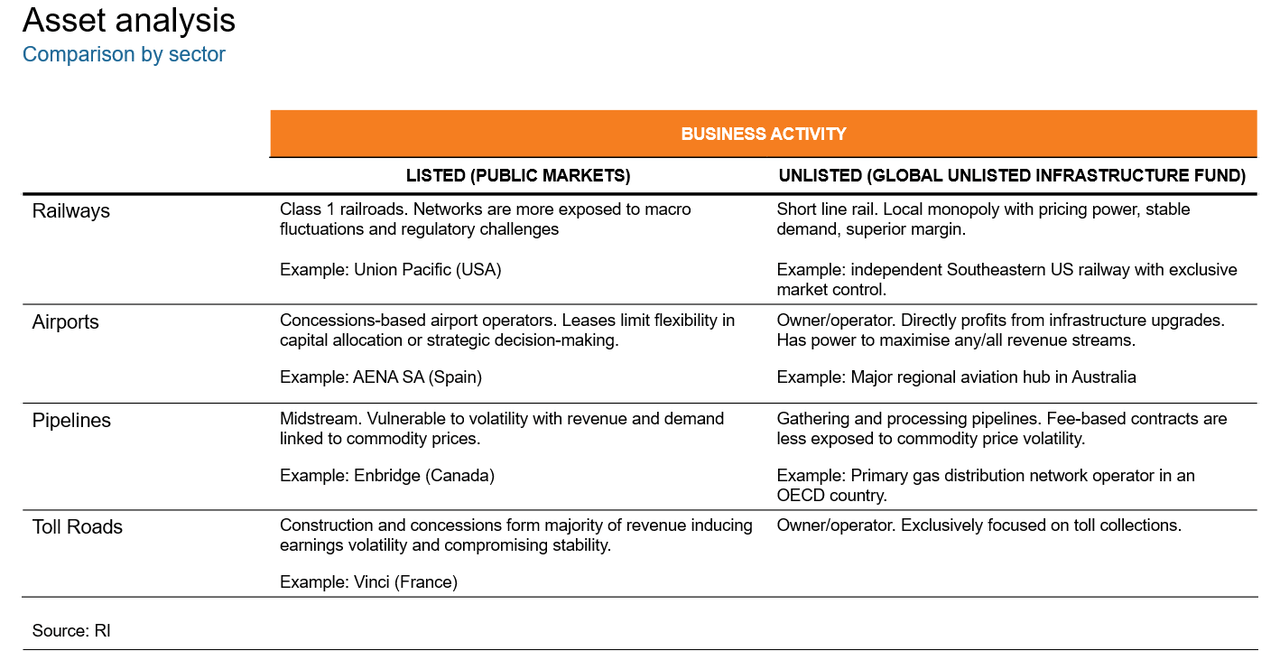gschroer/iStock via Getty Images
In today’s financial climate, marked by interest rate and geopolitical uncertainties, infrastructure investment offers financial and strategic opportunities. However, traditionally infrastructure portfolios have been divided into listed and unlisted segments, with investors choosing between one or the other. In practice, integrating both into portfolios strengthens investment approaches in the current economic landscape.
Risk and return profiles
Exhibit A
To understand how listed and unlisted infrastructure assets can complement another, it is necessary to appreciate their individual strengths. As illustrated in Exhibit A, listed infrastructure typically focuses on lower-risk profiles. Companies such as NextEra Energy and Union Pacific represent stable, mature assets with predictable revenue streams that are easier to trade. This makes them appealing to investors seeking income and lower volatility. However, these entities often reflect the broader market dynamics, making them susceptible to market fluctuations.
Exhibit B

Looking at a more detailed composition of the ten largest listed infrastructure segment in Exhibit B, reveals an even split between super-core and core assets. Super-core assets are typically those with extremely low risk and high predictability in cash flows, such as regulated utilities, while core assets, still low-risk, offer slightly higher returns and include sectors like toll roads and airports.
This balance between ‘super-core’ and ‘core’ within the largest listed infrastructure space underscores the sector’s appeal to a range of investors, particularly those looking to mitigate the impact of current economic turbulence while still positioning for growth. Interestingly, super-core assets have a lower weighted average cost of capital (WACC) as financial theory would suggest (source: RI, Bloomberg as of April 16, 2024).
Unlisted infrastructure
Conversely, unlisted infrastructure caters to a segment that favors direct control and higher yields. Investments in assets like an independent railway with exclusive market control in the Southeastern U.S. or a major aviation hub in Australia (shown in Exhibit C) allow for greater strategic management and potential upside from operational improvements. These assets often have lower correlation with financial markets and provide stable, long-term returns that are more insulated from market volatility.
Sector-specific analysis
Exhibit C
In Exhibit C, the distinctions become clearer when analyzing sector-specific strategies. For instance, in the railway sector, listed companies like Union Pacific face broad market risks and regulatory challenges, whereas unlisted entities enjoy localized monopolies with stable demand and superior margins. Similarly, in the energy sector, listed companies are more sensitive to commodity prices, whereas unlisted investments in assets like gathering and processing pipelines offer fee-based revenues that are less impacted by price swings. This distinction was particularly evident during 2020-2022 when energy prices swung wildly – initially plummeting as global demand collapsed during lockdown, then surged as economic activity surged. Throughout the turbulent zig-zag of energy prices, fee-based revenues from assets like pipelines remained stable, insulated from the extreme fluctuations affecting the broader energy market.
The flexibility in capital allocation and strategic decision-making also differentiates listed and unlisted investments. As highlighted in Exhibit C, listed airport operators typically work under fixed concessions, limiting operational flexibility. In contrast, unlisted operators, such as the controlling owner of an airport, benefit from the autonomy to enhance infrastructure and optimize revenue streams, directly profiting from any improvements made.
The bottom line
The synergy between listed and unlisted infrastructure investments is strong. Listed infrastructure offers liquidity and market correlation, making it suitable for investors seeking exposure to infrastructure with the flexibility of public markets. Unlisted infrastructure provides control, stability, and potential for higher returns, making it suitable for long-term investors focused on capital preservation and steady income.
When building portfolios, we believe investors should consider utilizing both segments of the market to maximize their opportunity to access attractive returns while maintaining resilience to market volatility and other financial stresses.
Disclosures
These views are subject to change at any time based upon market or other conditions and are current as of the date at the top of the page. The information, analysis, and opinions expressed herein are for general information only and are not intended to provide specific advice or recommendations for any individual or entity.
This material is not an offer, solicitation or recommendation to purchase any security.
Forecasting represents predictions of market prices and/or volume patterns utilizing varying analytical data. It is not representative of a projection of the stock market, or of any specific investment.
Nothing contained in this material is intended to constitute legal, tax, securities or investment advice, nor an opinion regarding the appropriateness of any investment. The general information contained in this publication should not be acted upon without obtaining specific legal, tax and investment advice from a licensed professional.
Please remember that all investments carry some level of risk, including the potential loss of principal invested. They do not typically grow at an even rate of return and may experience negative growth. As with any type of portfolio structuring, attempting to reduce risk and increase return could, at certain times, unintentionally reduce returns.
Frank Russell Company is the owner of the Russell trademarks contained in this material and all trademark rights related to the Russell trademarks, which the members of the Russell Investments group of companies are permitted to use under license from Frank Russell Company. The members of the Russell Investments group of companies are not affiliated in any manner with Frank Russell Company or any entity operating under the “FTSE RUSSELL” brand.
The Russell logo is a trademark and service mark of Russell Investments.
This material is proprietary and may not be reproduced, transferred, or distributed in any form without prior written permission from Russell Investments. It is delivered on an “as is” basis without warranty.
CORP-12494



